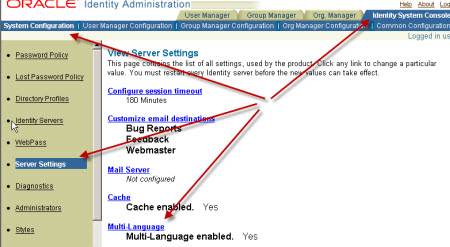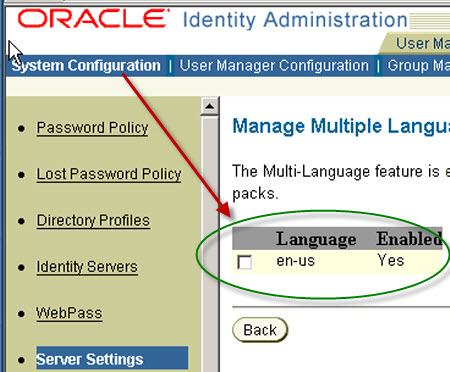Multi-Language or multi-lingual Support/Documentation for Oracle Access Manager (OAM)
This post cover Multi Language support for Oracle Access Manager (OAM). English is mandatory and default language with OAM
How to check what Languages are currently installed and configured in OAM ?
This is done via Manage Multiple Languages page on Identity System Console
1. Login to Identity System Console http://serverName:port/identity/oblix (where serverName and port is name and port number of web-server where WebPass is installed )
2. Click Identity system console
3. Select system configuration
4. Click Server Settings
5. click Multi-Language link at bottom of page
.
.
Key Points of Multiple Language Support in OAM
1. English is default and only language installed when you install Oracle Access Manager (OAM) with no Language Packs
2. English is always installed, regardless of the language (locale) that you choose as the default for Administrators and any other Language Packs you install.
3. Languages Supported with OAM are Brazilian Portuguese, Canadian French, Czech, Danish, Dutch, Finnish, French, German, Greek, Hebrew, Hungarian, Italian, Japanese, Korean, Latin American Spanish, Norwegian, Polish, Portuguese, Romanian, Russian, Simplified Chinese, Slovak, Spanish, Swedish, Thai, Traditional Chinese and Turkish
For complete list check Globalization and Multibyte Support chapter in OAM here
4. You can install Multiple Language with Oracle Access Manager either during Identity or Access System installation or later.
Note* If you prefer to install the Language Pack while installing each Oracle Access Manager component, the Language Pack installer must reside in the same temporary directory as the component installer.
5. When you install language pack with OAM, you can choose any Administrator Language to be used as default administrative activities.
6. You can include one or more Oracle provided Language packs during installation or you can install Language packs later independently. More here
7. After installing Language Packs with OAM, you must enable all languages that you want to use, and then configure OAM to use those language more information here
8. For each Language Pack, one Language Pack installer is provided for identity systems and one Language Pack installer for Access System.
8.1 OAM consist of Identity System (Identity Server, WebPass) and Access System (Access Server, WebGate, Policy Manager)
8.2 You must install Language Pack installer for Identity System on all identity system components i.e. Identity Servers and WebPass
8.3 similarly, You must install Language Pack installer for Access System on all access system components i.e. Access Servers , Policy Manager and WebGate
Note* Even though there is no user interface for Access Server and WebGate, you need to install same Language Pack for these components as well
9. You must use Language Pack installer for that specific version. Lets suppose you are installing Language Pack on Oracle Access Manager 10g (10.1.4.3) then use Language Pack installer for version 10.1.4.3, you can’t use lower/higher version of pack.
10. Translatable information (for Multi-lingual support) is mainly of two types
a) “End User Information” visible to all users
b) “Administrative Information” visible to users with Administrative access (mainly for configuration and setup screens)
.
11. When you install OAM with Multi-Lingual (Multi Language) support following things happen
i) On file system “/<lang tag>” folder is created in component_install_dir/oblix/lang for each language (like /fr)
ii) A language entry for each installed language is included under the configuration node in the LDAP directory as follows: obid=langTag and configDN
iii) \component_install_dir\identity|access\oblix\config\obnls.xml is updated for each installed language
12. It is possible to uninstall (remove) each installed Language Pack individually using appropriate file in component’s uninstall directory
.
Related/References
About the Author Atul Kumar
Oracle ACE, Author, Speaker and Founder of K21 Technologies & K21 Academy : Specialising in Design, Implement, and Trainings.


